Dec 7 2009
At its annual meeting in Freiburg, the German Thermoelectric Society (DTG) handed over its DTG Young Investigator Award 2009. Solid-state physicist Dr. Nicola Peranio from Tübingen was awarded for his work on bismuth telluride. The prize, worth €1500, was donated by Micropelt, thermoelectric specialist from Freiburg, and DTG. The DTG Young Investigator Award has been presented for the first time.
 Solid-state physicist Dr. Nicola Peranio from Tübingen (right) receives the Young Investigator Prize at the annual meeting of the German Thermoelectric Society (DTG). The prize, worth €1500, is handed over by Dr. Joachim Nurnus (left), representing Micropelt, and the first chairman of DTG, Ulrich A. F. Pfeiffer (centre).
Photo: Stefan Adolph / Fraunhofer IPM
Solid-state physicist Dr. Nicola Peranio from Tübingen (right) receives the Young Investigator Prize at the annual meeting of the German Thermoelectric Society (DTG). The prize, worth €1500, is handed over by Dr. Joachim Nurnus (left), representing Micropelt, and the first chairman of DTG, Ulrich A. F. Pfeiffer (centre).
Photo: Stefan Adolph / Fraunhofer IPM
This first presentation of the DTG Young Investigator Prize was made during the annual meeting of the German Thermoelectric Society (DTG) on 19th November 2009 in Freiburg. Solid-state physicist from Tübingen, Dr. Nicola Peranio, was awarded the prize for his doctoral research work on the structure, composition and properties of bismuth telluride. The prize was presented at the Fraunhofer Institute for Physical Measurement Techniques IPM.
Doctoral work on bismuth telluride awarded
Dr. Nicola Peranio's award-winning work showed that the low thermal conductivity of bismuth telluride, which is responsible for its excellent thermoelectric properties, is caused by a special structural characteristic of the material. Thus, the heat expansion in the crystal lattice in bismuth telluride is impeded by a periodic nanoscale structure. Dr. Nicola Peranio not only succeeded in imaging the structural change using transmission-electron microscopy but also provided a theoretical description.
Technology of the future: thermoelectrics
Thermoelectrics is used to convert heat into electricity or electricity into heat. Thermo¬electric energy converters, in the form of heat pumps, can use an electric current to produce a temperature difference, or use a temperature difference to generate an electric current. Both have huge economic and environmental potential. For example, the conversion of unused excess waste heat into electrical energy can potentially build an enormous new energy market.
DTG promotes young research scientists
The Young Investigator Award is donated jointly by the DTG and Micropelt from Freiburg. The prize is awarded for the best qualification work of the year in thermoelectrics which has taken place in Germany. The essential criteria for evaluating the work produced during doctorates, diplomas, and master's degrees are scientific or technological originality and a potential for new solutions or applications. This year, the prize has been awarded for the first time. The prize - worth €1500 - was donated by thermoelectrics specialist Micropelt and the German Thermoelectric Society.